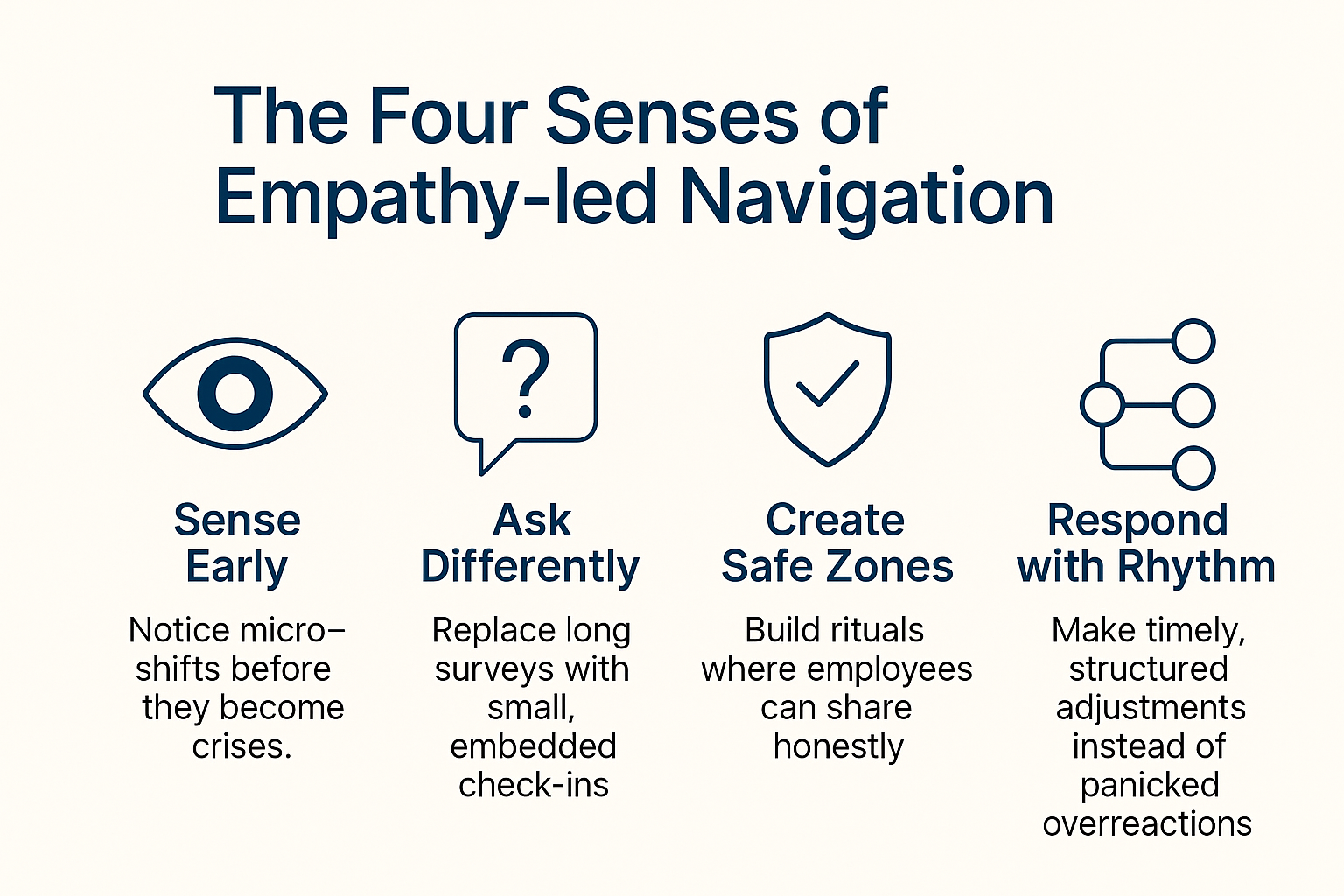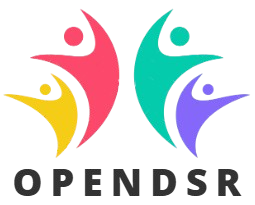
Empathy-led Navigation: The Heart of OPENDSR
Why Empathy Is No Longer Optional
Every organization talks about “listening to employees.” Yet many employees continue to feel unheard, unseen, and unsupported. Annual surveys ask for input, but responses vanish into dashboards. Feedback forms are filled, but actions are delayed or invisible. Leaders proclaim open-door policies, yet subtle cues—stress in voices, dips in participation, silent exits—go unnoticed.
This gap exists because listening alone isn’t enough. Data without interpretation is noise. Surveys without sensitivity are sterile. To truly design workplaces where people feel valued, organizations must move beyond measurement into navigation.
This is where Empathy-led Navigation, the second pillar of the OPENDSR framework, comes in. It’s the compass of OPENDSR—the mechanism that guides organizations through the unspoken signals, hidden struggles, and emotional landscapes of daily work.
What Is Empathy-led Navigation?
Empathy-led Navigation is the practice of sensing, interpreting, and responding to employee signals in real time.
It goes beyond formal channels (like surveys or HR portals) and pays attention to:
-
The tone of Slack messages.
-
The sudden silence of a once-engaged employee.
-
The collective sigh after a poorly timed meeting.
-
The spike in PTO requests after a product launch.
In OPENDSR, Empathy-led Navigation is not a “soft skill.” It’s an operating principle. Just like GPS guides a driver around traffic, empathy-led systems guide leaders around friction—before breakdowns occur.
Why Navigation Matters More Than Ever
The modern workplace is fast, fragmented, and often overwhelming. Remote and hybrid models blur boundaries. Tech platforms multiply. Expectations rise. And employees are less willing to tolerate environments that ignore their needs.
Here’s why navigation, not just listening, is critical:
-
Data overload, human underload.
Organizations have more data than ever, but little human interpretation. Empathy translates raw data into meaning. -
Silent disengagement.
Not all dissatisfaction is voiced. In fact, the most dangerous disengagement is often silent. Navigation detects what isn’t said. -
Manager burnout.
Leaders are told to “be empathetic” but lack tools. Navigation equips them with structured ways to notice and respond. -
Trust erosion.
Employees disengage not because surveys are absent, but because silence follows them. Navigation closes that loop visibly.
The Four Senses of Empathy-led Navigation
Just as humans have senses, organizations practicing OPENDSR use four “senses” to navigate with empathy:
-
Sense Early – Notice micro-shifts before they become crises.
-
Example: Drop in meeting participation signals workload stress.
-
-
Ask Differently – Replace long surveys with small, embedded check-ins.
-
Example: “How did that project handover feel?” instead of “Rate satisfaction 1–10.”
-
-
Create Safe Zones – Build rituals where employees can share honestly.
-
Example: Anonymous mood sliders in team huddles.
-
-
Respond with Rhythm, Not Reaction – Make timely, structured adjustments instead of panicked overreactions.
-
Example: If sentiment dips, leaders pause, regroup, and adjust workflows—not rush to patchwork fixes.
-
Case Example: The Slack Silence
A product team was thriving—until subtle changes appeared. Messages became shorter, humor disappeared, and turnaround slowed. On the surface, productivity metrics looked fine. But something felt off.
Instead of waiting for the quarterly survey, the manager used an OPENDSR tool—a “Feel Flow” micro-check:
-
“How does work feel this week?”
-
“What’s energizing? What’s unclear?”
Responses revealed that two key leaders had left, leaving the team overwhelmed. Within a week, priorities were recalibrated and rituals redesigned. Productivity bounced back.
Lesson: Empathy-led Navigation turns quiet signals into actionable insights—fast.
Mini Tools for Empathy-led Navigation 1. The Empathy Loop Card
Use in any 1:1 or team sync:
-
What are we sensing but not saying?
-
What might be happening under the surface?
-
What clarity or support could help?
2. Weekly Energy Retro
In retrospectives, ask three simple questions:
-
What gave us energy this week?
-
What drained us?
-
What should shift next week?
Document themes, not names. Build small course corrections.
3. Silent Signals Journal
Encourage managers to keep a weekly log of subtle observations: tone changes, attendance dips, or sudden quietness. Review them collectively during leadership syncs.
The Dangers of Getting It Wrong
Empathy-led Navigation is powerful—but misused, it can backfire.
-
Overreacting to noise. Not every dip in energy requires drastic action. Over-responsiveness creates instability.
-
Confusing empathy with indulgence. Empathy acknowledges feelings—it doesn’t mean avoiding accountability.
-
Assuming silence equals satisfaction. The absence of complaints is not proof of health.
Avoiding these traps requires balance: act with empathy, but ground it in patterns and rhythm.
From Empathy to Action: Closing the Loop
Navigation is incomplete without visible action. Employees must see that what they shared led to change—even small change.
Examples of closing the loop:
-
Sharing a “You Said / We Did” update in Slack.
-
Announcing small tweaks in weekly team meetings.
-
Acknowledging when something can’t be changed—but explaining why.
Credibility grows not from perfection, but from responsiveness.
Why Empathy-led Navigation Is the Heart of OPENDSR
OPENDSR has four pillars: Open Platform, Empathy-led Navigation, Design Standards, and Real-Time Intelligence. Of these, Empathy-led Navigation is the beating heart. Here’s why:
-
Open Platform ensures experiences are embedded in tools.
-
Design Standards ensure equity and inclusiveness.
-
Real-Time Intelligence ensures feedback leads to timely action.
But without empathy, these are mechanical. Empathy-led Navigation infuses humanity into the system. It’s the difference between collecting feedback and caring for people.
The Science Behind Empathy at Work
Modern neuroscience reinforces OPENDSR’s approach.
-
When employees feel seen, their threat response (amygdala activity) decreases. This opens up cognitive resources for creativity and problem-solving.
-
Empathy fosters psychological safety, a top predictor of high-performing teams according to Google’s Project Aristotle.
-
Leaders who practice empathetic navigation increase trust and retention. Deloitte studies show employees are twice as likely to stay when they feel understood.
Empathy isn’t just moral—it’s measurable.
Practical Applications Across the Employee Lifecycle
Onboarding:
Instead of generic surveys, new hires receive a “How are you feeling in week 1?” nudge. Managers adjust based on signals.
Development:
During stretch projects, managers use empathy loops to detect stress early. Support is added before burnout occurs.
Transitions:
Returning from leave? Empathy-led Navigation ensures re-entry conversations focus not just on tasks, but on how the employee feels about reintegration.
Exits:
Beyond exit interviews, managers notice disengagement signals earlier, creating opportunities to intervene before departure.
Real-World Story: The Finance Team Check-In
A finance team resisted surveys, claiming they were too busy. Instead, OPENDSR embedded a three-word “check-in nudge” during reporting cycles: Overwhelmed / On Track / Drained.
Over four cycles, managers used this micro-data to reshape workflows:
-
Cancelled one unnecessary standing meeting.
-
Shortened review sessions.
-
Introduced 30-minute “quiet windows.”
Trust improved. Absenteeism dropped.
This wasn’t HR magic. It was empathy operationalized.
Reflection Questions for Leaders
-
When was the last time you noticed a shift in team energy before it showed up in performance?
-
What silent signals might your teams be sending right now?
-
How do you close the loop on what you hear?
-
Where can you embed micro-checkpoints into existing workflows?
Empathy-led Navigation vs. Traditional Listening Traditional Approach Empathy-led Navigation Annual surveys Continuous sensing Open-door policies Structured safe zones Data reports Shared reflections Delayed response Visible, real-time action Silence = fine Silence = signal
The contrast is clear: one extracts data, the other designs with care.
Building a Culture of Empathetic Navigation
Empathy-led Navigation cannot be the job of HR alone. It must be a shared rhythm across managers, leaders, and teams. Steps to embed it:
-
Train managers in recognizing subtle signals.
-
Normalize vulnerability in team check-ins.
-
Systematize empathy by embedding prompts into workflows.
-
Celebrate empathy in action—share stories where signals led to real change.
Empathy as Infrastructure
Workplaces often collapse under the weight of disengagement not because they lack tools, but because they lack navigation. Empathy-led Navigation ensures employees feel not just surveyed, but seen.
It is the heart of OPENDSR because it brings humanity into structure, sensitivity into systems, and care into design.
In the end, the future of work will not be built solely on dashboards or strategies. It will be built on empathy—designed, practiced, and operationalized as infrastructure.
With Empathy-led Navigation, organizations no longer just listen. They navigate with care. And that makes all the difference.








